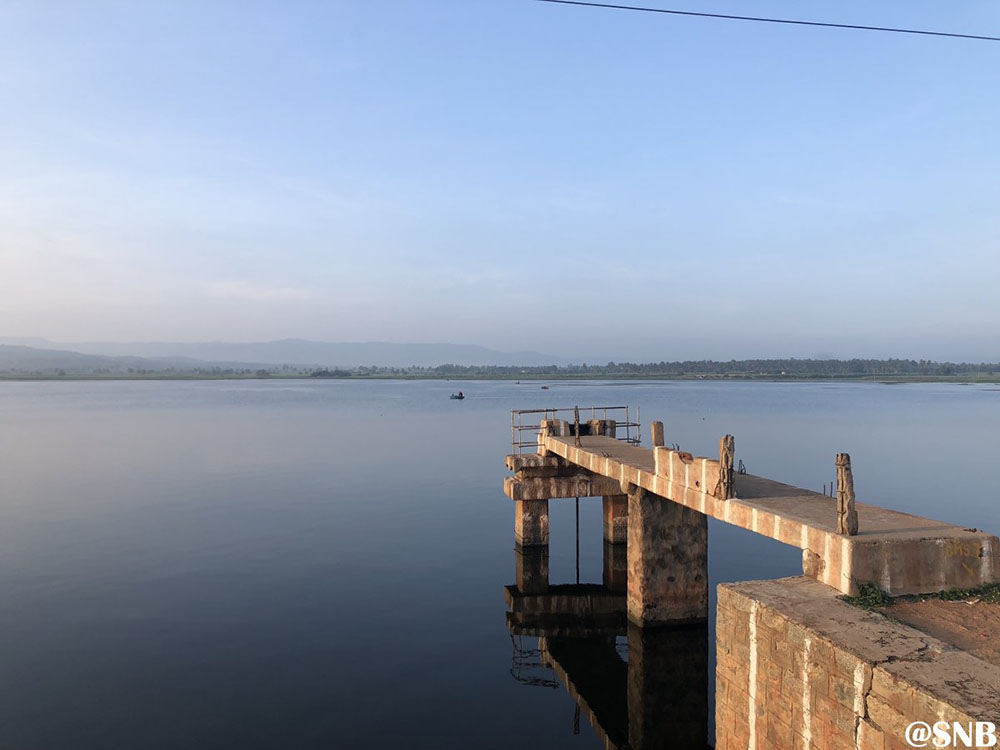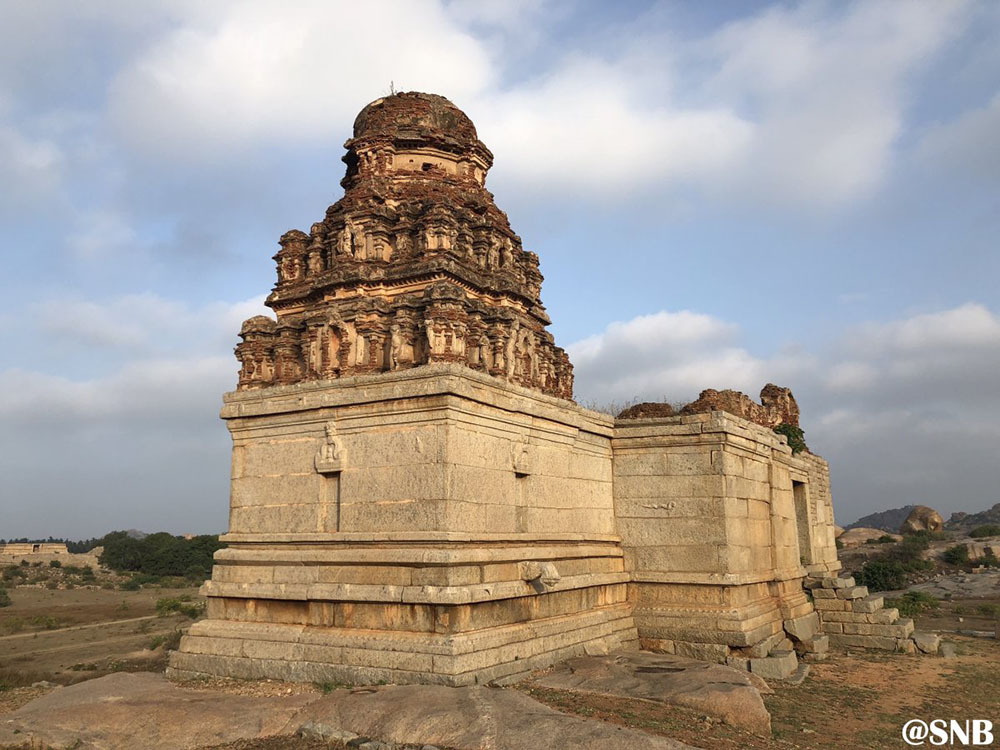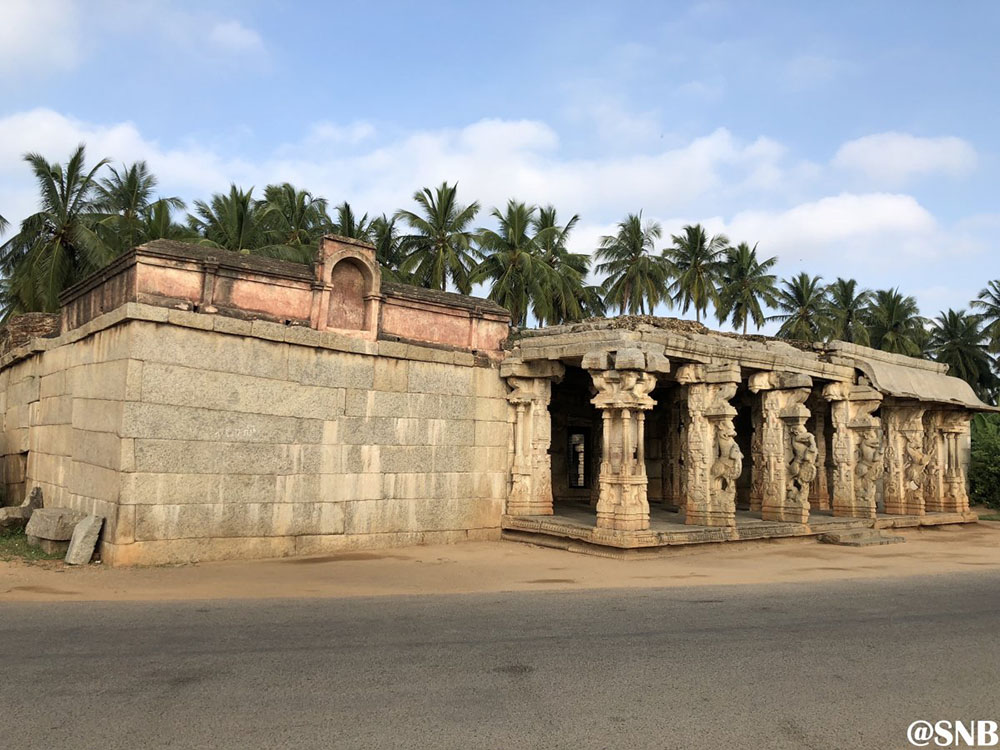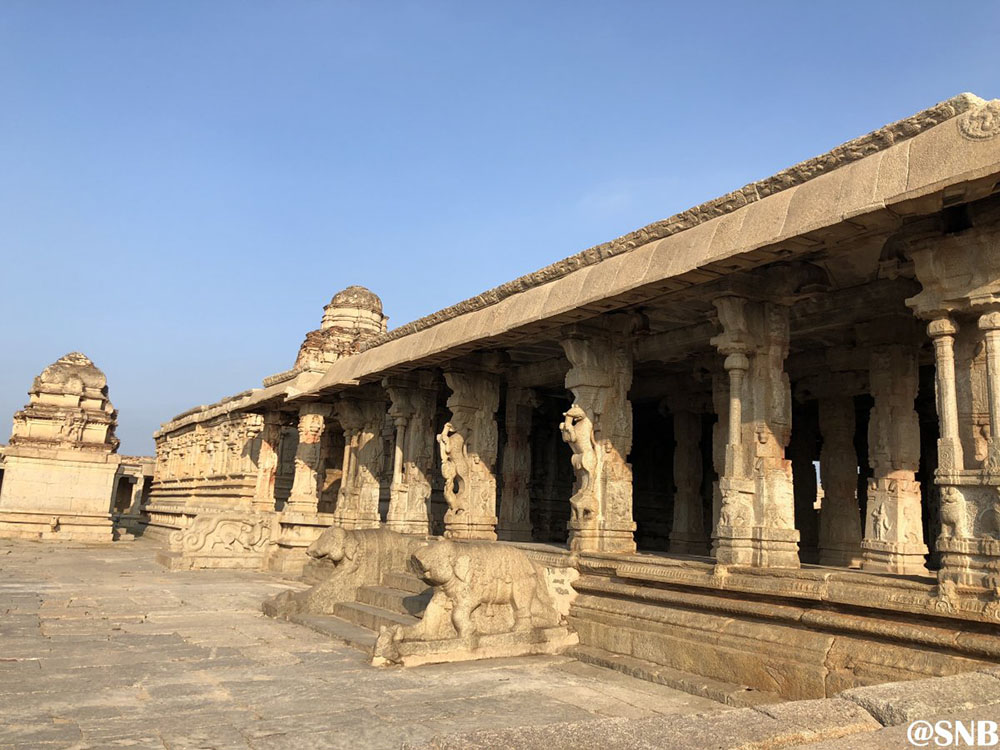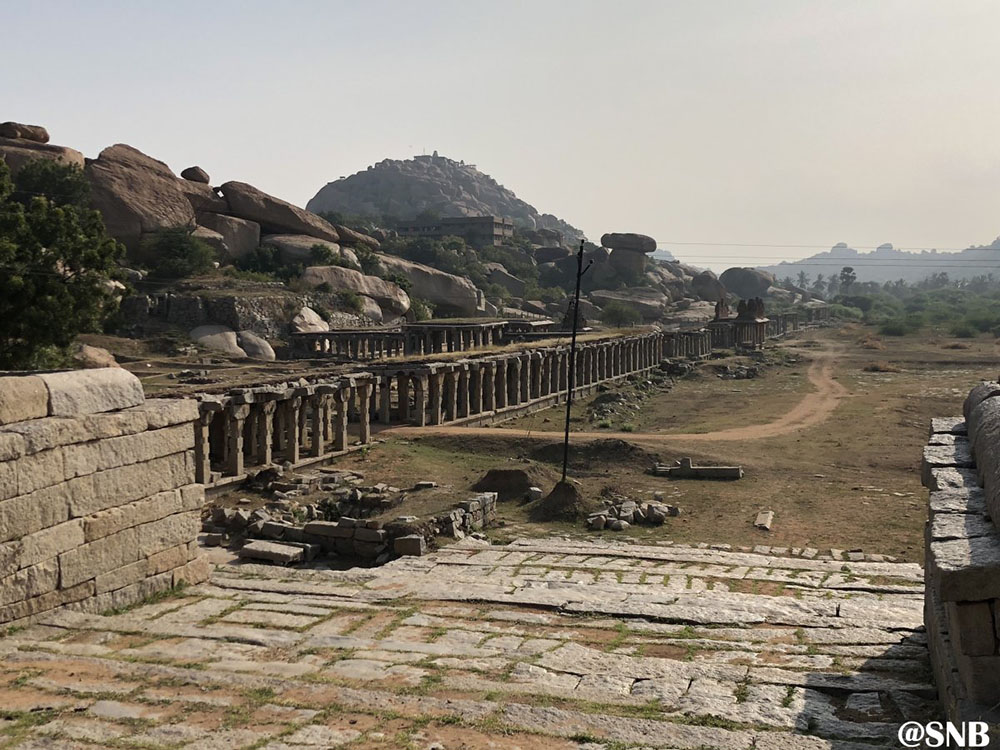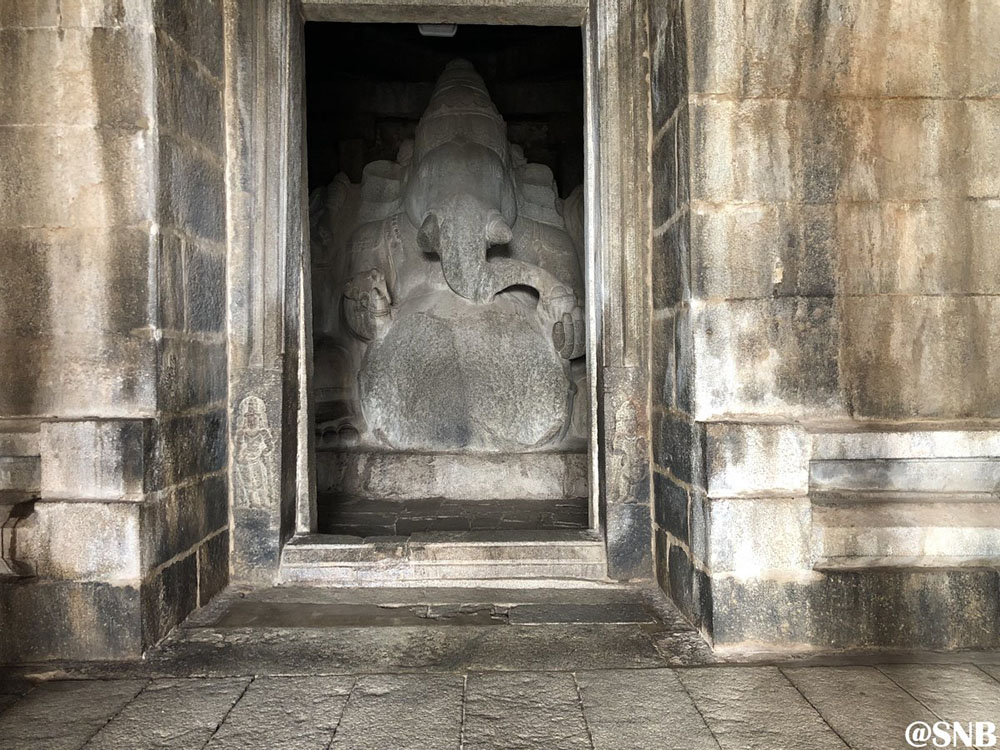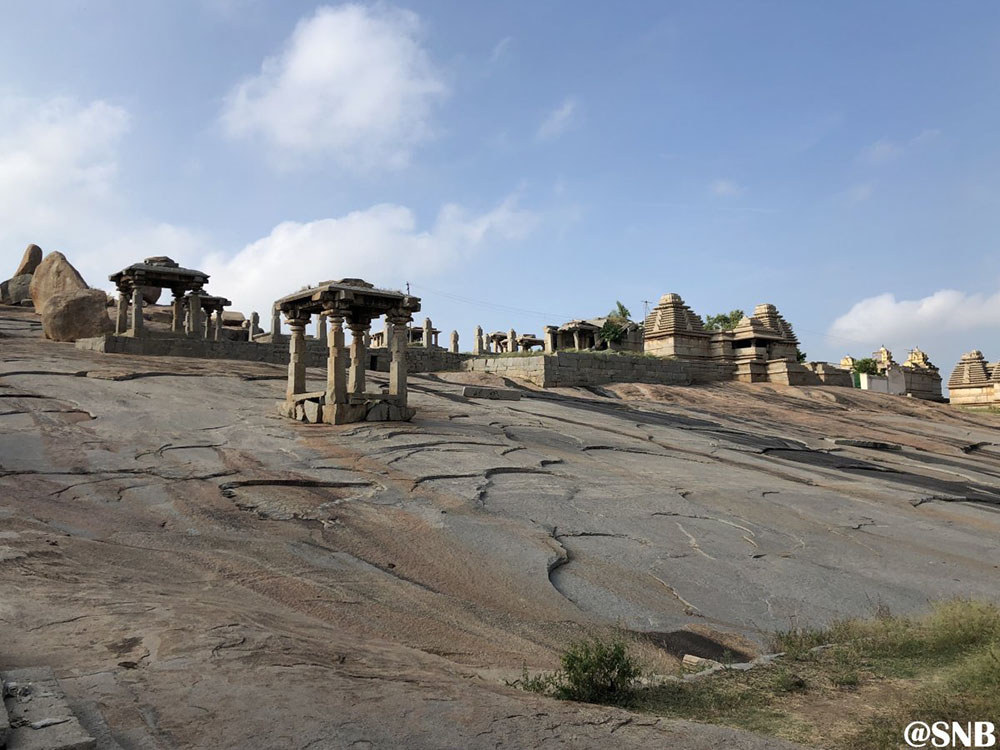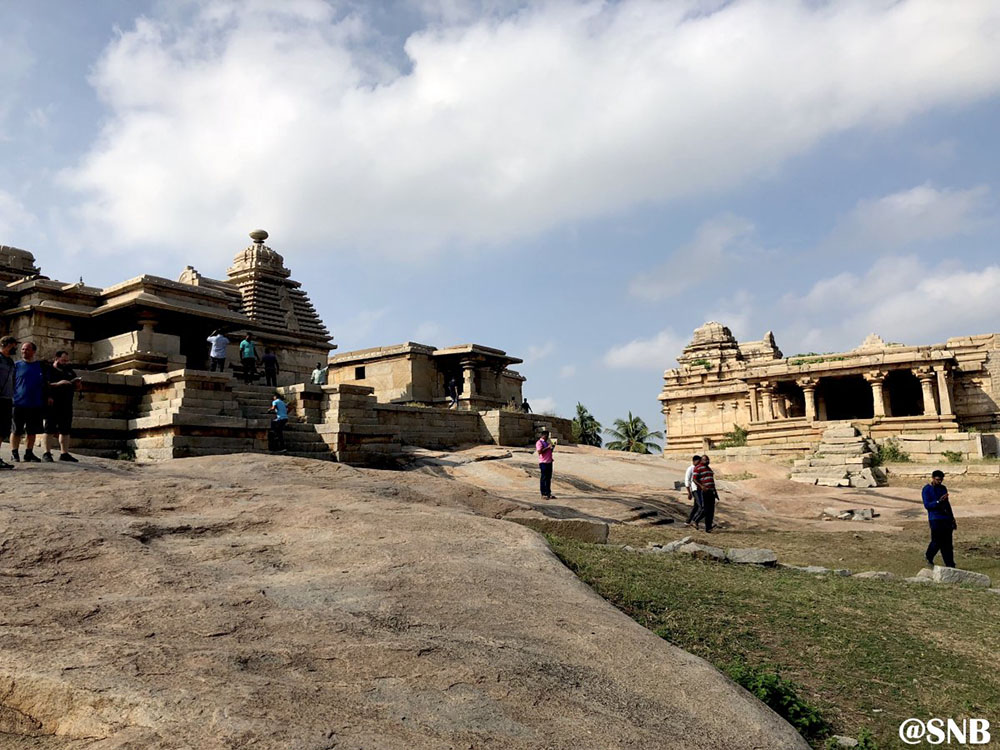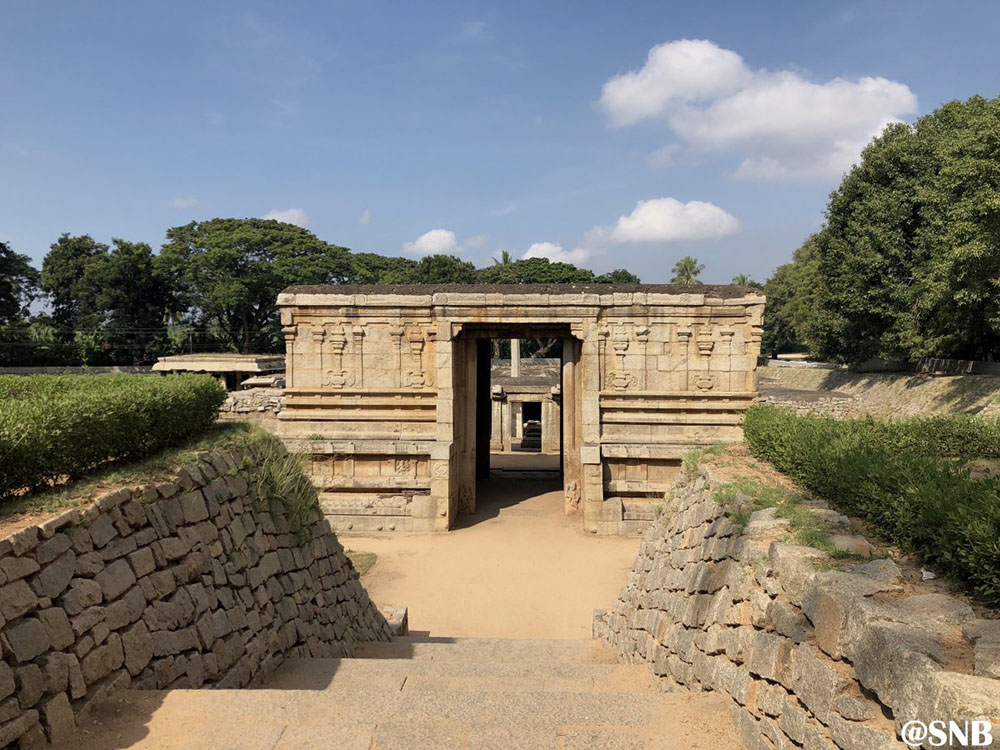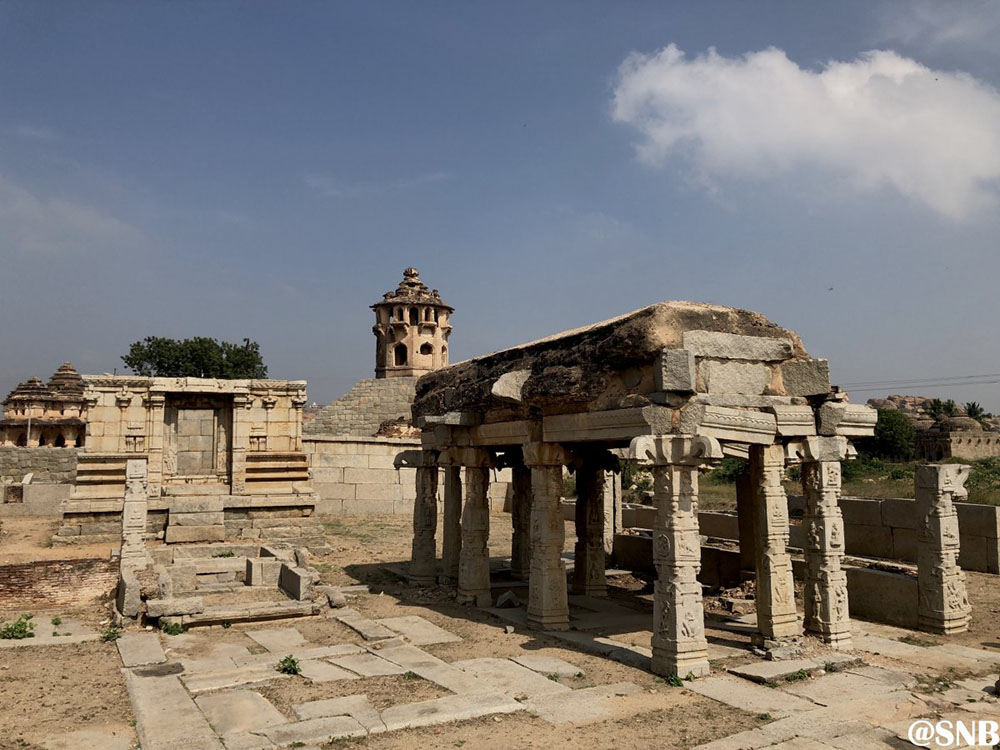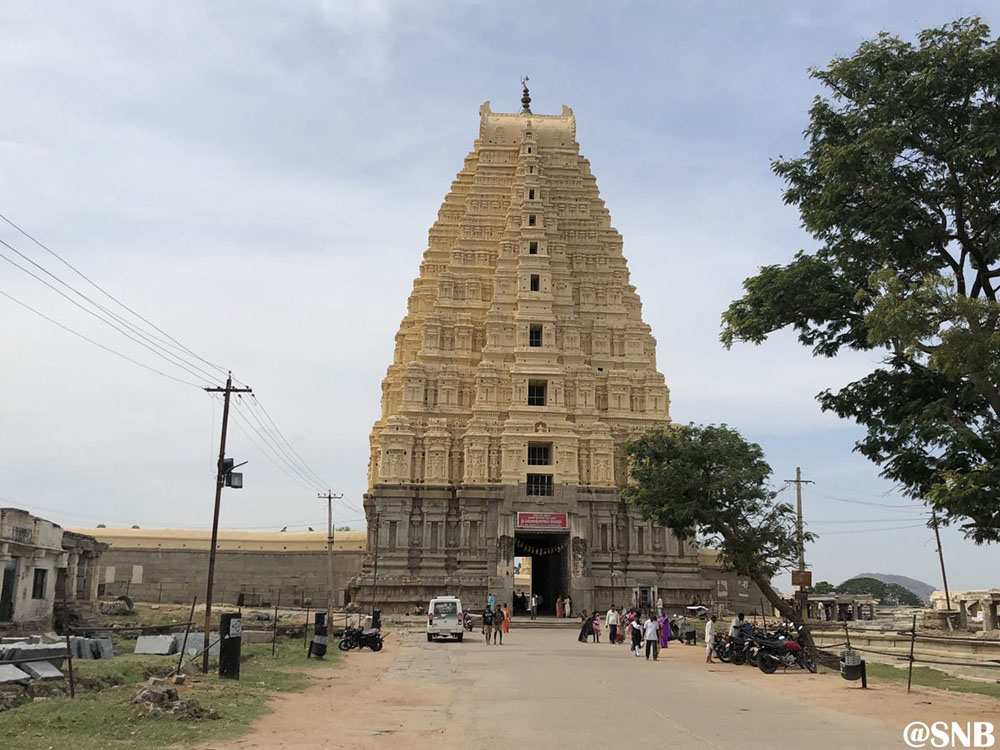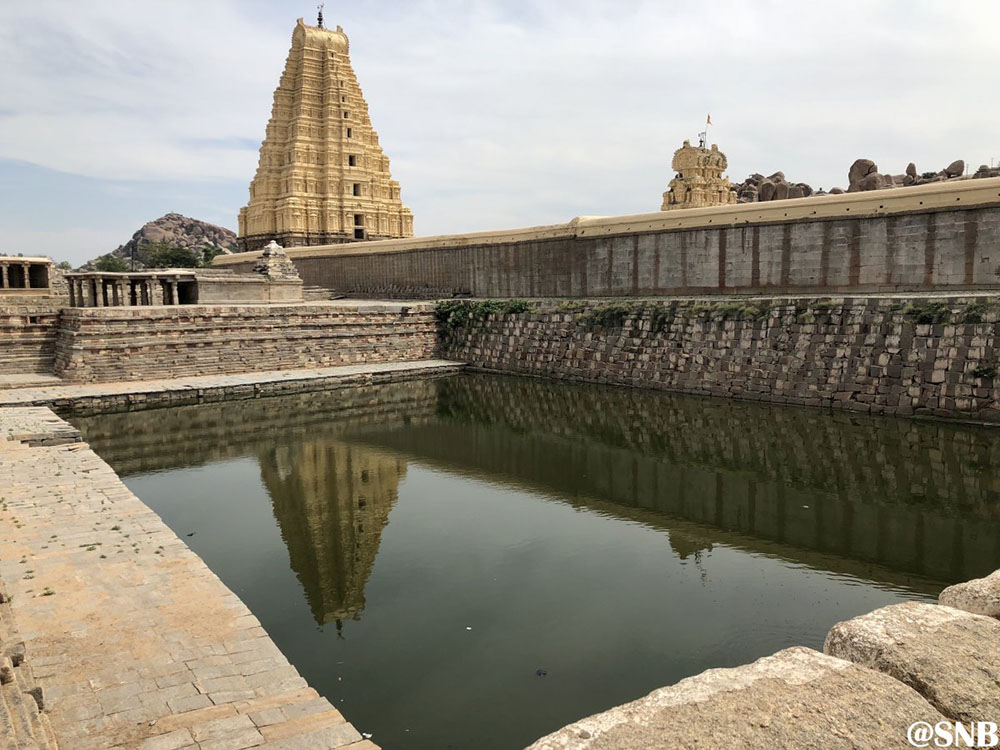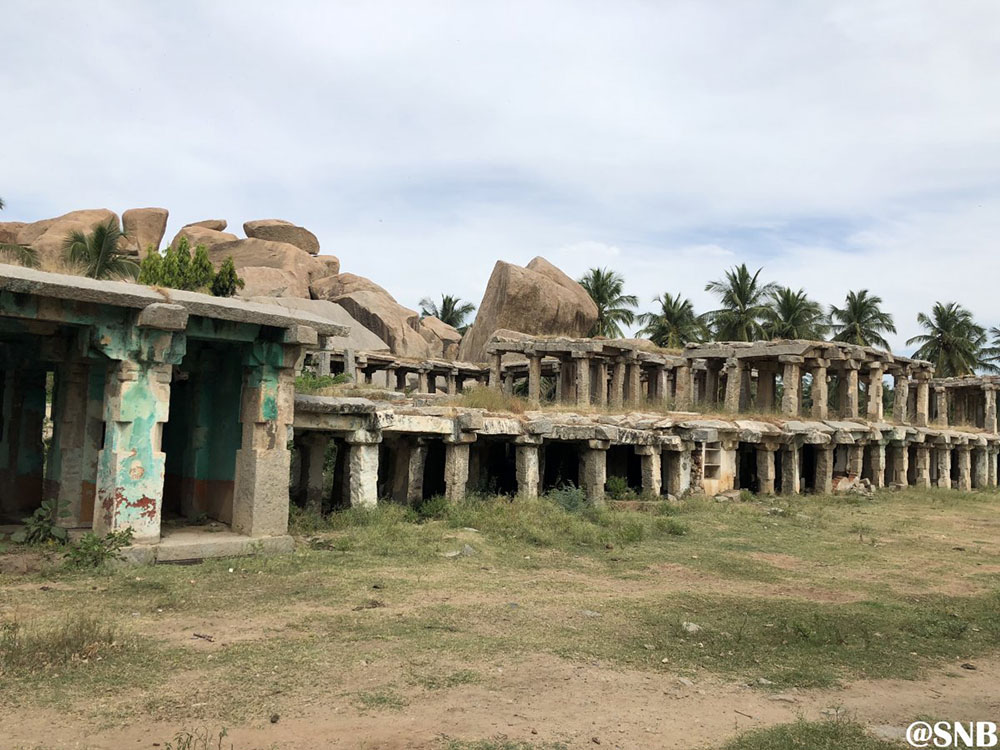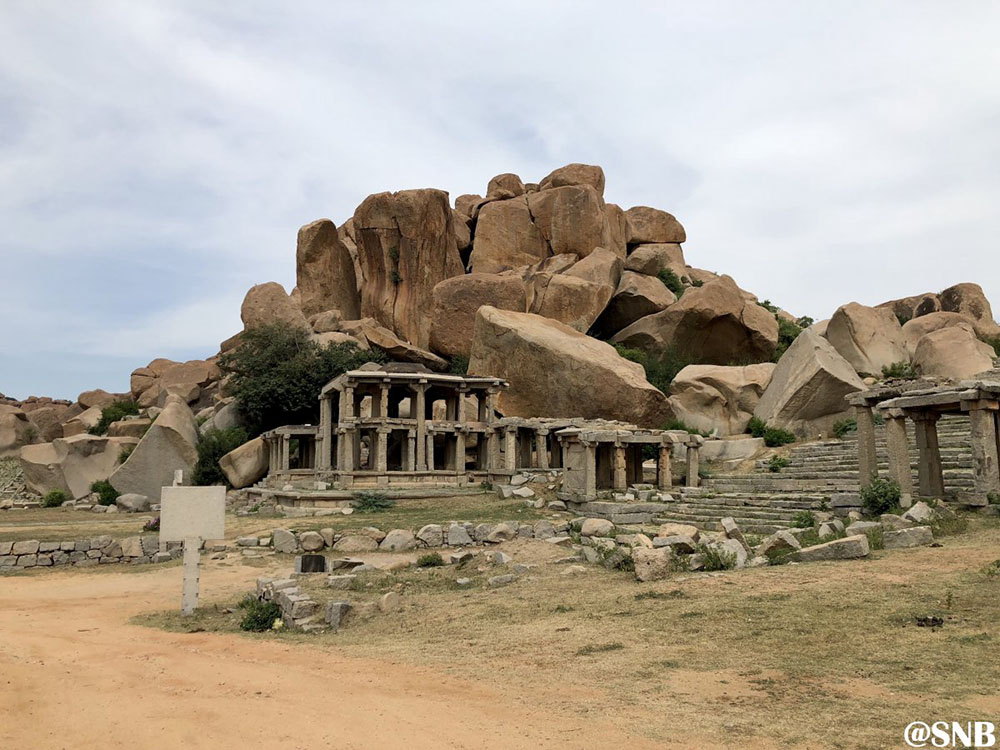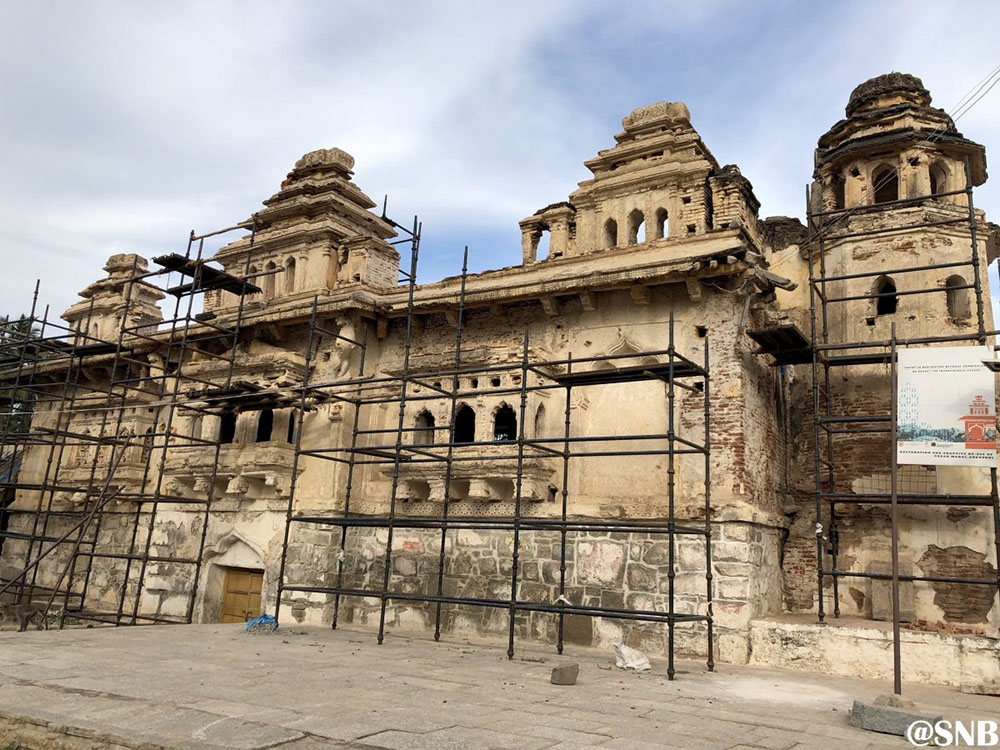As the previous two days’ travels were too hectic, the plan for this day was to keep travel light. Our sightseeing in Hampi was to start around 10 am, see Virupaksha temple, then go to Anegundi, which was the capital of Vijaynagara Kingdom before Hampi, and then proceed to Badami.
I am an early riser. So, I decided to use 3-4 hours to see some other attractions in Hampi which were neither seen yesterday nor part of this day’s itinerary. My brother-in-law unwillingly agreed to accompany me. Father-in-law, wife, and daughter decided not to dance with the tunes of my whims and fancies and decided to stay back at the Guest House.
Journey So Far:
- Day 1 – Mumbai to Hampi by Road
- Day 2 – Visiting the Tourist Attractions in Hampi & a Boat Ride in Tungabhadra River
This article is in continuation to a previous one and a part of my complete Hampi travelogue. To read the previous part of the post, please click on the links above.
Quick Navigation
Sightseeing in Hampi & Things to Do
We started from Karnataka State Tourism Guest House at 6.30 am with the target of returning by 9-9.30 am. This time we did not take Hampi road and straightway headed for Kamalapura. We stopped for a few minutes at the Kamalapura tank/lake to enjoy the early morning beauty of the rural surroundings and the water body.
Our first scheduled stoppage of the morning trip came immediately after taking the road for Virupaksha temple from Kamalapura. The stoppage is just before the Queens’ Bath. There are three attractions there – Chandrasekhara Temple, Saraswati Temple, and Octagonal Bath. We parked the car at the side of the road and started walking in an eastward direction. All three attractions are in the same direction.
Also Read: Bike Trip to Wayanad – A Ride to The God’s Own Country
Chandrasekhara Temple, Saraswati Temple & Octagonal Bath
Chandrasekhara temple is closest to the road. The main temple is protected by a high boundary wall with a decorated main gate. The main get is locked. We took a photo from outside and headed for Octagonal Bath and Saraswati Temple. These two attractions are further east and closely located to each other.
Our next stoppage was at Chandikeswara temple and Uddana Birbhadra temple. These two attractions are on the main Kamalapura – Virupaksha temple road and adjacent to each other. On the way, we crossed Queens’ Bath and Prasanna Virupaksha Temple (we visited this on the return leg of this morning trip).
Also Read: Mysore Coorg Ooty Road Trip – How to Plan & What to See
Chandikeswara Temple
Chandikeswara Temple is datable to the 16th century AD. It is an east-facing temple. The temple has a sanctum, vestibule, a Mahamandapa with entrances on north, south, and east, and a Mukhamandapa.
The pillars of the Mukhamandapa have roaring lions, trampling elephants, and Vyala sculptures. Most of the reliefs on pillars have Vaishnava representations like Hanuman, Garuda, Balakrishna, Kamdhenu, Srinivasa, Vamana, Yashoda churning milk, etc.
The Garbhagriha has a Pitha carved with the figure of Garuda. The brick-mortar superstructure over the Garbhagriha is treated with Stucco representation of Vaishnava sculptures.
Uddana Veerabhadra Temple
The Uddana Veerabhadra Temple is adjacent to the Chandikeswara Temple. This is one of the very few temples at Hampi which is a practicing temple.
This temple was also known as Midduviranna temple as per the inscription and was consecrated by Dalavayi Jangamayya in 1545 AD. The temple has a spacious Garbhagriha, an Antara, and pillared Mukhyamandapa. The image of Chaturbhuja Virbhadra which is 16 ft. high, is by far the largest image of Virbhadra of the Vijaynagara period found at Hampi.
The image of well sculptured Virbhadra bears bow and arrows at the upper right and left hand and the lower hands bear sword and shield.
Also Read: Bike Trip to Nandi Hills – Dawn At Hill’s Edge
Krishna Temple
Then we continued driving in the same direction until we reached Krishna temple. Krishna temple is at the junction of Hampi road and Kamalapura-Virupaksha temple road. It is in the same area where Lakshmi Narasimha temple, Badaviling temple, and Sasaivekalu (Muster Seed) Ganesha. At its prime, it was a grand temple.
The large and ornate, east-facing Krishna temple was consecrated with an icon of Balakrishna, brought from Udaygriri of Odissa by Krishnadevaraya, as indicated in the inscription dated 1513 AD.
The temple complex, built in Panchayatana style, with two enclosures, has the main shrine with sanctum, a vestibule, pillared pavilions and halls, a Devi shrine, and many sub-shrines. In addition, there is a kitchen towards the southeast of the main shrine and a separate store, housed in the first enclosure to the southwest.
The grand towered Eastern gateway is an outstanding example of Vijaynagara architecture. The temple walls are carved with depictions of the Bhagavata, the puranic story of Lord Krishna, and the life of the times. The pillars of Mahamandapa have sculptured depictions of the ten incarnations of Lord Vishnu.
Opposite to the Krishna temple, across the road, there are remnants of the Krishna Bazar and the Pushkarini. Krishna Bazar was the place for the spice trade during that time.
Adjacent to the Krishna Temple, there is a small housing complex. Probably, this was for the pilgrims in the heydays of Hampi. Today, those abandoned stone houses, are nothing but the mute spectators of history.
After visiting the Krishna temple, we again visited Lakshmi Narayana temple and Badaviling temple which were nearby. We spent some time there and took some photographs which I had already posted along with the description of the previous day.
Also Read: Bike Trip to Ooty – A Bike Ride from Bangalore to Ooty
Kadalekalu Ganesha Temple
Our next destination was Kadalekalu Ganesha temple. It’s is also very nearby to the Krishan temple. After Hampi village road crossing, as you proceed towards Virupaksha Bazaar, after a few hundred meters come Kadalekalu Ganesha temple at the left-hand side.
From there, the road starts going downhill towards the Virupaksha Bazaar. While Sasaivekalu (Muster Seed) Ganesha temple is on the southern slope of Hemkutha hill, Kadalekalu Ganesha temple is on the eastern slope of the Hemkutha hill.
There were remnants of old settlements just opposite the gate across the road. We parked our vehicle there.
The monolithic Kadalakelu Ganesha is so-called for the close resemblance of the to that of an unsplit Bengal Gram. The structure is carved out of a single granite boulder in situ and stands 4.5 meters high. This Ganesha structure is dated to the 15th century.
The seated structure has four arms and bears in each hand a tusk, goad, noose, and bowl. The monolithic structure is enshrined in a simple sanctum with a vestibule and an open ornate pillared pavilion in the front. The tall slender pillars are structured with depictions of various Hindu Gods and Goddesses.
After visiting the Kadalakelu Ganesha temple, we noticed that there were few old shelters at the backside of the temple. Behind those structures, there is a stone wall with a gate-like structure at its northern end.
There is a stone-paved path at the backside of the Kadalakelu Ganesha temple leading towards that gate from the gate of Kadalakelu Ganesha temple. So, we started walking in that direction. At that time, the morning sun rays were hitting the main gate (Gopuram) of the Virupaksha temple and it was looking majestic from a distance.
Hemkutha Hill Temple Complex
Once we reached the gate and crossed it, we realized that we have reached the main Hemkutha hill temple complex. The first look at the temple complex mesmerized us completely.
We approached the top of the Hemkutha hill previous days from its southern slope. But the majority of the temples are on its northern slope facing Virupaksha temple and Tungabhadra River.
The hill is encircled on its three sides by massive fortification. To the north is the enclosure wall of Virupaksha temple. The complex has three gateways with more than thirty shrines on the hill. The shrines vary from elaborate structures with multiple sanctums to rudimentary single-celled constructions. Most of the temples have stepped pyramidal type of superstructure.
Two of the temples on Hemkutha hill have inscriptions. The triple Shiva temple on the east has an inscription recording that Vira Kampiladeva, son of Mummadi Singeya Nayaka, built the Shivalaya and installed three ‘lingas’ inside it.
Two inscriptions on the rock near Prasanna Anjaneya temple mentions that Virupaksha Pandita and his brother constructed a temple of Virupaksha and dug a tank. Another inscription on a rock base records the setting of a lamp pillar in the temple of Jadeya Sankaradeva by Bukkavaye, the queen of Harihara II in the year of 1397 AD.
These temples form on the earliest group of structures at Hampi and appear to date from about the 9th century to the early 14th century and all of them are clearly of Shaiva origin.
We spent around 45 minutes there and left for our next destination at 9.45 am. What I feel is that in order to see all the temples on Hemkutha hill complex someone needs 2-3 hours.
Prasanna Virupaksha Temple
Our next stoppage was Prasanna Virupaksha temple which was on the return path. We did not go to the Virupaksha temple because the plan was that we would visit that temple with the entire family.
Prasanna Virupaksha temple, as mentioned in its inscription, is also known as an underground temple because the main structure of the temple is beneath the current ground level.
The temple has a Garbhagriha, aligned with an Antarala and Ardhamantapa and Mahamantapa. The Mahamantapa has pillared corridors fuse with the pillared Mukhamantapa making a larger frontal pillared Mantapa which also encloses a Dwajastambha.
The pillars of this temple are plain. The temple is stylistically datable to the 14th century. An inscription referring to the temple states that Krishnadevaraya donated Nagalpura and other villages for worship and offering to God for the merit of his parents Narsa Nayaka and Nagajidevi.
As mentioned in the post of the previous day, the gravel road that emanates from Kamalapura-Virupaksha temple road at Queen’s Bath for going to Royal Enclosure, Hazararam temple, and Zenana Enclosure, again comes back to the Kamalapura-Virupaksha temple road at Prasanna Virupasksha temple. We took that road again but in opposite direction.
The objective was to cover a few places of interest along that road which we skipped yesterday because of the paucity of time.
Our next stoppage was the Mohammedan watchtower, Band tower, and the mosque. No description is available at the sight of these attractions. Probably, these were built by the victorious forces of the Deccan Sultanate during their brief stay at Hampi.
Also Read: Road Trip to Madikeri – Boat Rafting in Madikeri
Mint Area
Then came the mint area, the Palace of Vira Harihara, and the basement of King’s palace. This area is adjacent to Hazararama temple, at its west. No superstructure is there today. Only the basement is visible and ruins of some grand superstructure on that.
The traditional Mint is located here. As per the two inscriptions, discovered in 1996-97, this used to be referred to as ‘Silamantapa’.
This area has an identified complex of structures (excavated between 1994-95 and 1997-98) and as per the inscriptions, this was the palace complex of Virharihara (1337-1404 AD), the third ruler of the Vijaynagara dynasty firmly confirming the establishment of the citadel and its structures to the rules of Sangama dynasty.
The excavated remains consist of a great eastern entrance, elephant alighting platform, the royal court, the residential quarters of the royal women and the king, the royal kitchen, and other accessory structures all provided in zig-zag entrances and a well-planned water supply system.
Among these structures, the royal courts, the residence of the king, the well-laid garden in front of it, and the huge water storage tank with Nandimukha inlet speaks volumes of the early Vijaynagara secular architecture of the royalty.
The same palace complex has earned the epithet of Hiriya Aramne (Elderly palace) during the time of Krishna Devaraya (1509 -1529) AD.
At Prasanna Virupaksha temple, at Mohammedan tomb, and at the mint area too, we saw some semi-excavated structure at the other side of the dirt road. Those structures were ring-fenced by an iron railing and there were no descriptions. So, we could not figure out what those structures are. But it became amply clear that this area was the epicenter of the Vijaynagara kingdom.
Madhava (Ranga Temple)
The next destination was Madhava (Ranga Temple). It is adjacent to Zenana Enclosure, on its eastern side. There is a walking trail from the entrance of the zenana enclosure along its boundary wall which leads to the Madhava (Ranga) temple.
Madhava (Ranga) temple, dedicated to Madhava, was built along with its Devi shrine in an east-west orientation. The temple has a garbhagriha, a vestibule and large 18 pillared Mukhamantapa.
The temple is known for its colossal structure of Hanuman which is three meters high and placed on Mukhamantapa. The Devi shrine is built on a raised Adhisthana of 2.5 meters in height.
An inscription at the time of Sadashivraya in the temple dated to 1545 AD records the construction of Rangamantapa for the God Madhava by Timmaraju, son of Vallabharaju exclusively for holding dance, vocal and instrumental music concerts in the temple.
The pillars of the temple have sculptural descriptions of Garuda, Vitthala, Surya, Balakrishnan, Hanuman, and Alwar.
It was already 10.30 am whereas we were supposed to be back at KSTDC Guest House by 9.00 am. Further, we were feeling hungry since we did not have breakfast. So, we started straightway for KSTDC Guesthouse from here.
When we reached the KSTDC guest house, everyone was ready. So, I and my brother-in-law immediately took bath, had breakfast, and then started for Virupaksha temple.
Virupaksha Temple
We reached Virupaksha temple around 12.45 pm.
Virupaksha temple is a temple of Lord Shiva. It is the oldest temple of Hampi. It is also one of the very few practicing temples at Hampi.
The temple’s history is uninterrupted from about the 7th century. The Virupaksha-Pampa sanctuary existed well before the Vijayanagara capital was located here. Inscriptions referring to Shiva date back to the 9th and 10th centuries.
What started as a small shrine grew into a large complex under the Vijayanagara rulers. Evidence indicates there were additions made to the temple in the late Chalukyan and Hoysala periods, though most of the temple buildings are attributed to the Vijayanagar period.
The main entrance of the temple is from the east, from Virupaksha Bazar. This 50-meter high, nine-tiered entrance, has a brick superstructure and stone base. It gives access to the outer court containing many sub-shrines.
Then there is a smaller gate that gives access to the inner court. At the inner court, there is a sanctum, a few ante chambers, a pillared hall, and an open pillared hall.
There are another two gates for the inner court. One towards the north and another towards the south. While the Southern gate leads to Hemkutha Hill, the northern gate gives access to the Pushkarini and Tungabhadra.
We finished the Virupaksha temple visit around 1.30 pm and then started walking towards the other end of the Bazar in an eastwardly direction. While walking, we took some photographs of remnants of the Bazar which, in its heydays, was the center of gold trading.
From this end, walking trails for Matanga Hills, Achtya Raya temple, Vittala temple started.
Kamalapura Market
But we did not have enough energy to do the walking. So, we spent some time there, saw Monolithic Bull and the convention center, took some photographs of the bazaar, and then proceeded towards Kamalapura market for lunch.
We had our lunch at the same place and started for Anegundi around 3.15 pm saying goodbye to Hampi.
In total, we spent 1.5 days at Hampi, and in my opinion, that was inadequate. In order to see Hampi in detail, in order to let Hampi grow on you, at least 3 days should be spent here. I would definitely come back here again.
Anegundi
Anegundi is older than Hampi and was the capital of Vijaynagara Kingdom before Hampi. It is believed to be the monkey kingdom of Kishkindha in the epic of Ramayana, which is at a distance of 5 km east of Hampi and situated on the northern bank of Tungabhadra.
We reached Anegundi around 3.45 pm. On the way, we crossed Tungabhadra. After reaching Anegundi, we first went to the Ranganatha Swamy temple.
After that, we went to Anegundi palace which is under renovation. It was a bit let down.
Then we set Pampa Sagar on Google Map and started driving. But after some time, Google Maps was also confused. There was no one there to give us any guidance. So, we stayed at that place for a few minutes took some photographs, and started for Badami.
- Journey Ahead: Badami Cave Temples – Local Sightseeing in Badami
With hindsight, I think, we should have either gone to Anegundi with more time in hand and with a guide or directly gone to Badami from Hampi. Please click on the link above to continue reading the next part of this travelogue.
Sightseeing in Hampi – Conclusion
I hope the travelogue, pictures, and information on sightseeing in Hampi were of help. If you have any questions or need any other details, please feel free to ask in the comments section below or at our Community Forum, and I will be happy to answer. You can also follow me on Instagram and chat with me live there or subscribe to my YouTube channel and ask a question there.

